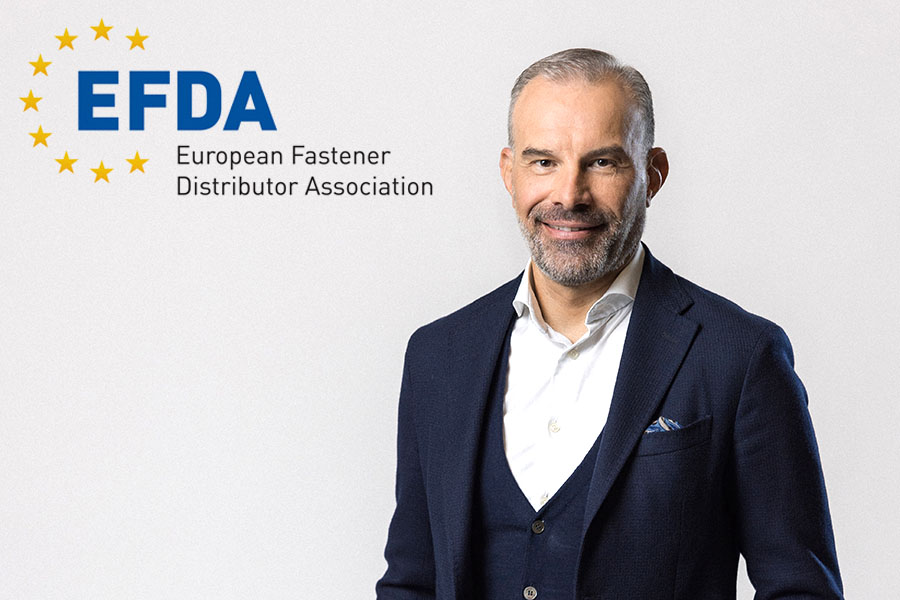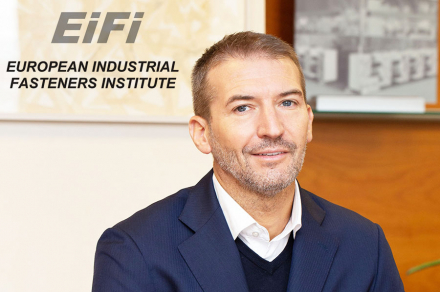GOVERNMENTS/ASSOCIATIONS/FASTENER GROUPS
Interview with EFDA President ANDREAS BERTAGGIA


Add to my favorite
2025-11-21
1. Since early this year, President Trump's tariff measures have dealt a heavy blow to the global economy, throwing global industrial supply chains including the fastener industry into disarray. The repercussions brought by the tariffs continue to reverberate among the industry. How do you assess the actual impact of the U.S. uncertain tariff policies on EU fastener distributors?
According to my calculations, the US imported around 13% of its total imports from the EU. I assume that the bigger portion comes from EU fastener manufacturers and a smaller portion of EU distributors. From this perspective, there is an impact on direct exports especially for the manufacturer. On the other hand the alternative for US importers to buy domestically are also somehow small. However, from an indirect perspective, where EU distributors sell to local OEM producers, the impact of tariffs is significant because those OEM producers may have a larger share of their turnover in US exports. Therefore, it will affect EU distributors as well in demand and price pressure as well.
2. Amid the disruption caused by steel and aluminum tariffs, many manufacturers who previously focused their exports on the U.S. have shifted their business to other countries (particularly the EU) to avoid tariff impacts. Based on your observations and available data, have there been any significant changes in the EU's fastener imports and exports since the implementation of these tariffs?
Currently, demand in the EU market is stable for the time being. The main sources are established, and prices generally remain at lower levels. If the economic outlook strengthens and demand rises, this may lead to increased sourcing opportunities, capacities, and competition. Ongoing changes in the supply market may influence future developments.
3.“Construction” and “automotive” have always been the major applications for fasteners globally. Could you briefly share the current demand status in the EU market for these two industry sectors?
The construction and automotive segments account for 40% of the EU fastener market in 2024. The construction sector appears to be stable, whereas the automotive sector is currently experiencing challenges due to various factors.
4. Earlier reports indicated that the EU may consider adjusting the scope of entities required to report carbon emissions under the CBAM to target “only upstream major emitters (e.g., raw material suppliers)”, exempting downstream fastener processing plants with negligible carbon emissions from reporting obligations. Such an adjustment (if proved to be true) is expected to significantly reduce the burden of collecting carbon emission data for downstream processing facilities. Regarding this matter, do you have any recent official updates or responses from the EU?
EFDA succeeded in persuading EU legislators to reduce the emissions relevant to CBAM to those emissions released during the production of precursors for fasteners. This means that emissions released during the production of the fastener itself will no longer be taken into account. This significantly reduces the administrative burden on fastener manufacturers outside the EU and should make CBAM somewhat easier to apply overall. The EU legislator has already made the fundamental decision in favour of this change. However, an implementing regulation from the European Commission is still required to specify the details.
5. Beyond tariffs and CBAM, what other market factors do you believe are challenging the supply and demand of fasteners in the EU or creating additional business opportunities that everyone should start paying attention to?
Given current uncertainties, adaptability is crucial. With unpredictable geopolitical and economic shifts, regionalising suppliers and adopting multi-sourcing can help minimise supply chain risks. Meanwhile, some market segments continue to drive strong demand for fasteners, making agility, openness, and a positive mindset essential.
6. At the writing of this interview outline, the trade show dedicated to fastener technology, Fastener Poland, was about to commence. Compared to the already mature fastener markets in Western Europe, what are your observations on the future prospects of the fastener markets in Central and Eastern Europe?
You are correct; compared to the mature and saturated market of Western Europe, Eastern Europe still has significant potential for increased fastener demand. Additionally, many factories continue to relocate production from Western to Eastern Europe.
7. Over the past few years, we have observed several major European fastener distributors enhancing their competitiveness by continuously expanding their market footprint across different sectors. This has been achieved through acquisitions of European peers or establishing operational bases in overseas markets such as Southeast Asia. What are your thoughts on this trend?
I completely agree—expansion is a natural strategy for market participants in any industry. Growth can be achieved through gaining market share, mergers and acquisitions, or both, and some even pursue vertical integration of their supply chain.
8. Besides the General Assembly that just concluded in Brussels at the end of September, what other significant membership or international exchange events has EFDA scheduled?
Following a highly successful 8th European Fastener Distribution Conference on 25–26 September 2025 in Brussels, attended by 120 guests, the focus will now shift to internal EFDA meetings. These include regular meetings of the EFDA Task Force, which primarily deals with ongoing anti-dumping measures such as the current antidumping investigation of the European Commission regarding imports of screws without head, including threaded rods, originating in the People's Republic of China, and other issues of international trade policy and the regulation of the supply chain. In addition, the EFDA CBAM Working Group meets very regularly to assist European fastener distributors with the implementation of CBAM, e.g. through the EFDA Template for Suppliers. The EFDA Assembly of Delegates is expected to meet in Amsterdam in autumn 2026. The 9th EFDA Conference is scheduled to take place in 2028 as this is a triennial conference. We will announce more details about this event at a later date.
歐洲扣件經銷商協會
理事長ANDREAS BERTAGGIA
美國鋼鋁稅
建築
車用
CBAM
區域化分配
多元採購
中東歐市場
會員大會
反傾銷
EFDA
President Andreas Bertaggia
U.S. steel and aluminum tariffs
construction
automotive
regionalising suppliers
multi-sourcing
Central and E. European markets
anti-dumping
members meeting
扣件
國際展會
惠達雜誌
匯達實業
外銷媒合
廣告刊登
螺絲五金
五金工具
緊固件
台灣扣件展
印度新德里螺絲展
越南河內螺絲展
墨西哥瓜達拉哈拉螺絲展
美國拉斯維加斯螺絲暨機械設備展
2026美國鳳凰城螺絲暨機械設備展
波蘭克拉科夫螺絲展
義大利米蘭螺絲展
德國司徒加特螺絲展
德國杜塞道夫線材展
Fastener
Hand Tool
Hardware
Component
Fastener World
Wire Dusseldorf
Fastener Fair India
Fastener Fair Vietnam
Fastener Fair Mexico
Fastener Poland
Fastener Fair Italy
IFE
Fastener Fair Global
Chicago Build
READ NEXT

Subscribe







